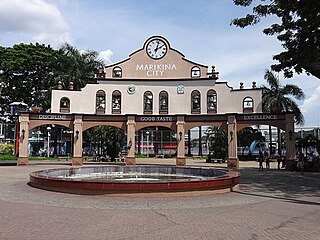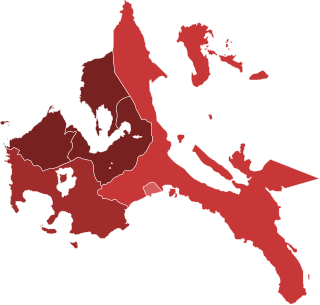
Metropolitan Manila, officially the National Capital Region, is the seat of government and one of three defined metropolitan areas in the Philippines. It is composed of 16 highly urbanized cities: the city of Manila, Quezon City, Caloocan, Las Piñas, Makati, Malabon, Mandaluyong, Marikina, Muntinlupa, Navotas, Parañaque, Pasay, Pasig, San Juan, Taguig, and Valenzuela, as well as the municipality of Pateros. The region encompasses an area of 619.57 square kilometers (239.22 sq mi) and a population of 13,484,462 as of 2020. It is the second most populous and the most densely populated region of the Philippines. It is also the 9th most populous metropolitan area in Asia and the 5th most populous urban area in the world.

Manila, officially City of Manila, is the capital of the Philippines and its second-most populous city. Manila is located on the eastern shore of Manila Bay on the island of Luzon. It is highly urbanized and as of 2019, was the world's most densely populated city proper. Manila is considered to be a global city and is rated as an Alpha – City by Globalization and World Cities Research Network (GaWC). It was the first chartered city in the country, and was designated as such by the Philippine Commission Act 183 of July 31, 1901. It became autonomous with the passage of Republic Act No. 409, "The Revised Charter of the City of Manila", on June 18, 1949. Manila is considered to be part of the world's original set of global cities because its commercial networks were the first to extend across the Pacific Ocean and connect Asia with the Spanish Americas through the galleon trade; when this was accomplished, it was the first time an uninterrupted chain of trade routes circling the planet had been established. Manila is among the most-populous and fastest-growing cities in Southeast Asia.

Laguna, officially the Province of Laguna, is a province in the Philippines located in the Calabarzon region in Luzon. Its capital is Santa Cruz while its largest city is the City of Calamba and the province is situated southeast of Metro Manila, south of the province of Rizal, west of Quezon, north of Batangas and east of Cavite. Laguna hugs the southern shores of Laguna de Bay, the largest lake in the country. As of the 2020 census, the province's total population is 3,382,193 . It is the seventh richest province in the country.

Rizal, officially the Province of Rizal, is a province in the Philippines located in the Calabarzon region in Luzon. Its capital is the city of Antipolo. It is about 16 kilometres (9.9 mi) east of Manila. The province is named after José Rizal, one of the main national heroes of the Philippines. It is bordered by Metro Manila to the west, Bulacan to the north, Quezon to the east and Laguna to the southeast. The province also lies on the northern shores of Laguna de Bay, the largest lake in the country. Rizal is a mountainous province perched on the western slopes of the southern portion of the Sierra Madre mountain range.

Ninoy Aquino International Airport, originally known as Manila International Airport (MIA), is the main international airport serving the city of Manila and the metropolitan area of the same name. Located between the cities of Pasay and Parañaque, about 7 kilometers (4.3 mi) south of Manila proper and southwest of Makati, NAIA is the main gateway for travelers to the Philippines and serves as a hub for AirSWIFT, Cebgo, Cebu Pacific, PAL Express, and Philippine Airlines, and as the main operating base for Philippines AirAsia. Named after Senator Ninoy Aquino (1932–1983) who was assassinated at the airport on August 21, 1983, it is managed by the Manila International Airport Authority (MIAA), an agency of the Department of Transportation (DOTr).

The Ateneo de Manila University, also known simply as the Ateneo de Manila, the Ateneo, or AdMU, is a private, research, basic and higher education institution along the historic Katipunan Avenue in Quezon City, Philippines. Founded in 1859 as Escuela Municipal de Manila, the school was founded and is run by the Society of Jesus, and is the second-oldest Jesuit-administered institution of higher learning in Asia-Pacific.

Pasig, officially the City of Pasig, is a 1st class highly urbanized city in the National Capital Region of the Philippines. According to the 2020 census, it has a population of 803,159 people.

Marikina, officially the City of Marikina, is a 1st class highly urbanized city in the National Capital Region of the Philippines. According to the 2020 census, it has a population of 456,159 people.

Antipolo, officially the City of Antipolo, is a 1st class component city and capital of the province of Rizal, Philippines. According to the 2020 census, it has a population of 887,399 people. It is the most populous city in the Calabarzon region, and the seventh most-populous city in the Philippines.

Cainta, officially the Municipality of Cainta, is a 1st class municipality in the province of Rizal, Philippines. According to the 2020 census, it has a population of 376,933 people.

Biñan, officially the City of Biñan, is a 1st class component city in the province of Laguna, Philippines. According to the 2020 census, it has a population of 407,437 people.

Taytay, officially the Municipality of Taytay, is a 1st class municipality in the province of Rizal, Philippines. It is also known as the Garments Capital of the Philippines. Most occupation of the residents are related to supplying different types of garments related things like blouses, pants, dresses and the garment itself at a very low cost. According to the 2020 census, it has a population of 386,451 people. It is the 2nd most populous municipality in the country, after Rodriguez, Rizal.

Destiny Cable was a direct-to-home cable television subscription service based in Quezon City. Destiny Cable was the 2nd largest cable TV provider in the Philippines. It was owned by Sky Cable Corporation.

Polytechnic University of the Philippines is a coeducational state university in Manila, Philippines. It was founded on 19 October 1904, as the Manila Business School (MBS) and as part of Manila's public school system. It was eventually promoted to a chartered state university in 1978, by virtue of Presidential Decree 1341. PUP has more than 20 branches and campuses across Central Luzon, Southern Luzon and Metro Manila. With over 70,000 enrolled students, PUP claims to be the largest state university in the Philippines by student population.

Sta. Lucia Mall is a shopping mall owned by Sta. Lucia Realty & Development Inc. It is situated at the intersection of Marcos Highway, and Felix Avenue, located at Barangay San Isidro, Cainta, Rizal, Philippines, beside Robinsons Metro East.
The geography of the City of Manila is characterized by its coastal position at the estuary of the Pasig River that flows to Manila Bay. The city is located on a naturally protected harbor, regarded as one of the finest harbors in Asia. The scarce availability of land is a contributing factor that makes Manila the densest populated city in the world.

Ortigas Avenue is a 15.5 km (9.6 mi) highway running from eastern Metro Manila to western Rizal in the Philippines. It is one of the busiest highways in Metro Manila, serving as the main thoroughfare of the metro's east–west corridor, catering mainly to the traffic to and from Rizal.
The following is a timeline of the history of the city and metropolitan area of Manila, the capital city of the Philippines.

The New Clark City Sports Hub or the New Clark City Sports Complex is a complex of sports facilities located inside the National Government Administrative Center of New Clark City in Capas, Tarlac.

The COVID-19 pandemic in Calabarzon is part of the worldwide pandemic of coronavirus disease 2019 caused by severe acute respiratory syndrome coronavirus 2. The virus reached Calabarzon on March 7, 2020, when the first case of the disease was confirmed in Rizal. All provinces in the region has confirmed cases. As of October 19, 2021, the region has 486,176 confirmed cases, with 5,048 deaths.

















